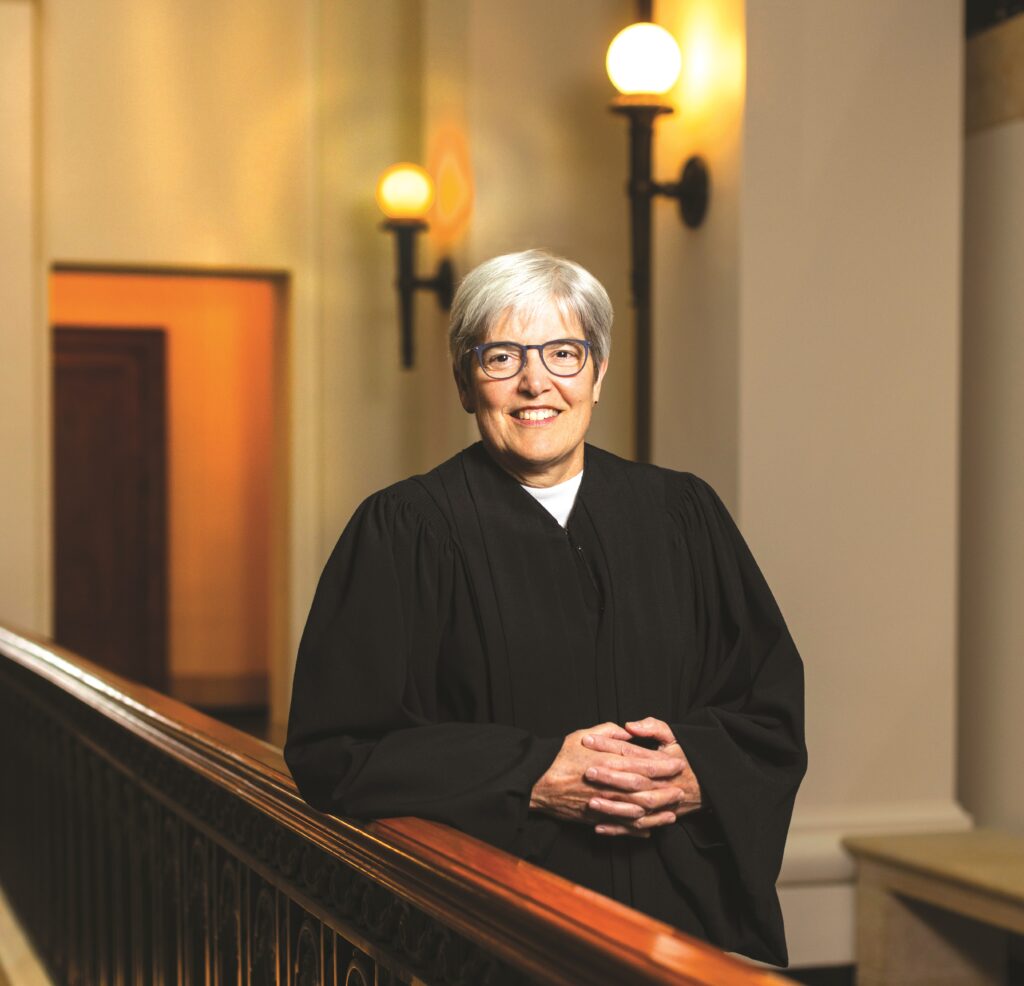Nine years ago, the Minnesota Women Lawyers organization created a Parity Task Force to evaluate the position of women lawyers in the state.
The task force (which eventually morphed into the Minnesota Women Lawyers Equity Committee) wanted to identify barriers to parity and come up with effective methods to overcome those barriers, but it was important to determine a baseline number of women in Minnesota’s legal profession. The group’s 2014 Gender Data Project found 63 percent of lawyers registered in Minnesota were male and 37 percent were female. The 2019 Follow-Up Report saw a slight uptick with men at 61 percent and women at 39 percent.
“The 2014 study was groundbreaking in providing the first-ever baseline number of female attorneys in the state of Minnesota,” the report stated.
“The Gender Data Project was an important step in better understanding how to tackle the inequities,” said Lisa Brabbit, senior assistant dean for external relations and programs at the School of Law, and past president of Minnesota Women Lawyers. “Inequities feed off interests, and they live in systems. Understanding how to dismantle these systems requires, in part, an analysis of the data. Minnesota Women Lawyers continues to be a leader in this space.”
Minnesota is not the only state with a gap between men and women in the legal profession – states all around the country have similar issues. Nationwide studies show women are paid less, promoted less and are represented less in high-ranking positions compared to their male colleagues in the law profession.
National Outlook
The National Association of Women Lawyers (NAWL) 2018 Survey looking at the retention and promotion of women in law firms points out females have made up about 50 percent of law students for more than a decade and are recruited for entry-level associate positions on the same level as men. This stands in stark contrast to who is elevated to prominent positions in firms.
Women make up 20 percent of equity partners at law firms, which the NAWL points out is a “sluggish, upward trajectory over the past 12 years” from 15 percent in 2006. The numbers drop to only 2 percent for women of color. When women do make equity partners, they work as many hours as men, but only match 92 percent of men’s client billings due to decreasing billing rates for women.
According to the survey, more than 90 percent of firms said their top earner was a man. Male attorneys also make up the majority of the 10 most highly compensated lawyers in a firm.
In a joint study between the Commission on Women in the Profession and the American Bar Association, "A Current Glance at Women in the Law" shows that 35 percent of attorneys are women, with 26 percent of women making up the general counsel in Fortune 500 companies. On average, a female lawyer’s weekly salary was 77 percent of her male colleague's in 2016. This was a decline from 89 percent in 2015 and 86 percent in 2011.
No surprise that gender inequality in law does not stop at firms – it is also felt in courtrooms. "The Gavel Gap: Who Sits in Judgment on State Courts?" study reports that state courts handle more than 90 percent of the country’s judicial business, but the people sitting on the bench do not fully represent the diversity of the country’s population. The report found:
- “Women have entered law schools and the legal profession in large numbers for the last 40 years, but are underrepresented on state courts. Women comprise roughly one-half of the U.S. population and one-half of American law students. But, less than one-third of state judges are women. In some states, women are underrepresented on the bench by a ratio of one woman on the bench for every four women in the state. Not a single state has as many women judges as it does men.”
Interrupting Racial and Gender Bias
"You Can’t Change What You Can’t See – Interrupting Racial and Gender Bias in the Legal Profession," a report published by the American Bar Association’s Commission on Women in the Profession, examines implicit gender and racial bias in everyday interactions in legal workplaces and how this bias affects law firm and in-house attorneys.
The report identified four main patterns of gender bias:
- Prove-It-Again: The need for women and people of color to work harder to prove themselves.
- Tightrope: The narrower range of behavior expected of, and deemed appropriate for, women and people of color, with both groups more likely than white men to be treated with disrespect.
- Maternal Wall: Documented bias against mothers.
- Tug of War: The conflict between members of disadvantaged groups that may result from bias in the environment.
The report found that women of all races reported doing more administrative tasks compared to their male colleagues. Women of color were 35 percent more likely than white men to report Prove-It-Again bias, with white women at 25 percent in this category.
Women and people of color reported higher levels of bias than white men did when it came to the issues of equal hiring opportunities, receiving fair performance evaluations, being given high-quality assignments, earning fair pay and being promoted.
Twenty-five percent of women said they had experienced sexual harassment in the workplace. Women also said they lost career opportunities because they rejected sexual advances at work.
The second part of the report includes Bias Interrupter Toolkits to help interrupt gender and racial bias in law firms and in-house departments – specifically in the areas of hiring, assignments, performance evaluations, compensation and sponsorship best practice recommendations. The toolkits take a three-step approach: the use of metrics, the implementation of bias interrupters and repetition, as needed. Steps include everything from changing the wording in a job description and tracking a job’s candidate pool through the hiring process to “empowering people involved in the hiring process to spot and interrupt bias.”
Bias Against Mothers
In the "You Can’t Change What You Can’t See" report, after having children, women said they were treated worse when returning to work, were given less important “mommy track” assignments and had their level of commitment and competence questioned.
A large part of the disparity in pay and advancement between men and women is attributable to the fact that women tend to have primary responsibility for caring for children, said Elizabeth Schiltz, John D. Herrick Professor of Law and co-director of the Terrence J. Murphy Institute for Catholic Thought, Law, and Public Policy.
(The following quotes from Schiltz are a summary of arguments she makes in the article “Motherhood: Benefit or Burden to Business?” in Public Justice Review, Vol. 4 2017.)
“Realistically, this disparity is only going to be addressed if we can figure out some way to properly value the work of raising children,” Schiltz wrote. “We all agree that we need to ensure future generations of healthy, capable citizens and workers, if only to take care of us as we age, and pay taxes. It is unjust to make women pay the disproportionate cost of doing something that benefits all of society.”
There’s a “motherhood wage penalty” that mothers are up against, Schiltz said. They earn less than women without children, and men, whether they have children or not.
“This motherhood wage penalty persists in research that controls for reduced work hours and reduced productivity,” Schiltz wrote. “Research also shows that employers stereotype mothers as less competent and committed than other workers with the same backgrounds. One study had people watch a video of a woman interacting with others in a work scenario; when the woman appeared to be pregnant, she was given lower performance and work commitment ratings, even when the scenarios were identical. Another study asked participants to evaluate resumes for attorneys and found that mothers were held to stricter standards than fathers and were disadvantaged in hiring and promotion.”
Making Changes
Guidelines, groups and programs have been put in place in varying degrees throughout the law profession to push back against implicit bias and other social constructs that keep women and minorities from achieving parity with their white male counterparts. In some cases, laws have been passed to ensure women and minorities are represented in certain roles.
In Minnesota, there is a Judicial Selection Commission made up of 49 members – 27 appointed by the governor and 22 appointed by the Minnesota Supreme Court – whose duty it is to screen judicial candidates and make recommendations to the governor for all Minnesota district court openings. In Minnesota Statute 480B.01, it stipulates, “The appointing authorities shall ensure that the permanent members of the commission include women and minorities.”
In the NAWL 2018 Survey studying the retention and promotion of women in law firms, questions about bias interruption interventions were raised. It was found firms were more likely to engage in these processes and procedures earlier in the process – 89 percent of the time at recruitment, 86 percent of the time at hiring – however, that number started to decline as job levels rose – 58 percent at promotion, 44 percent at elevation to nonequity partner, and 54 percent at elevation to equity partner.
An effort to collect more data also has been made in Minnesota. According to the Minnesota Women Lawyers Gender Data Project, after learning statistics on the number of women practicing law in Minnesota was not being collected, “Chief Justice Gildea, with the support of other Minnesota Supreme Court members, authorized a change to the Minnesota Attorney Registration form. In 2011, attorneys had the opportunity to voluntarily identify their gender.”
Five years later, the Minnesota Lawyer Registration Office began collecting race and ethnicity information in addition to gender data from attorneys during the lawyer registration process. Responses became mandatory after a “choose not to answer” option was added.
“As a result, for the first time, in its 2016 Annual Report of the Minnesota Judicial Branch, the Court provided a statistically significant summary of the demographic data now being collected. This report marked another important milestone in the effort to better understand the makeup of the Minnesota legal community.”
In the introduction to the 2019 Follow-Up Report, Minnesota Women Lawyers acknowledged the data it collected is valuable, but more long-term and comprehensive research is needed to gain a better understanding of the makeup of the Minnesota legal community.
While some progress has been made, there is still plenty of work to do until parity and equality among the sexes are achieved in the legal profession.
St. Thomas Law takes these issues seriously.
“We challenge our students to look for ways to tackle inequities, using the competencies they develop in law school,” Brabbit said. “When they graduate, we hope they carry a whole-person approach with them as they serve their communities.”







